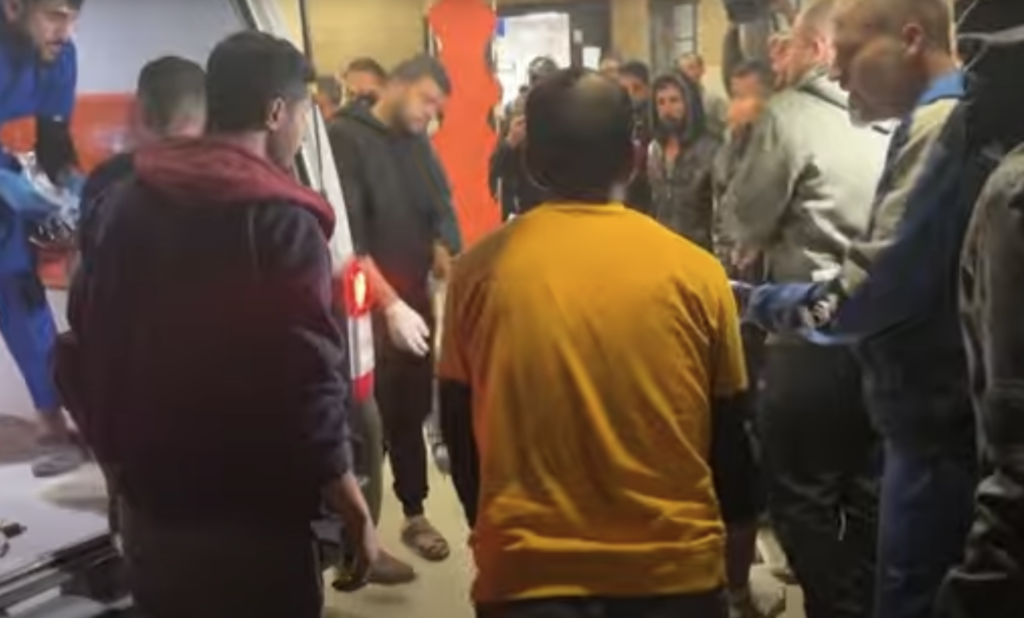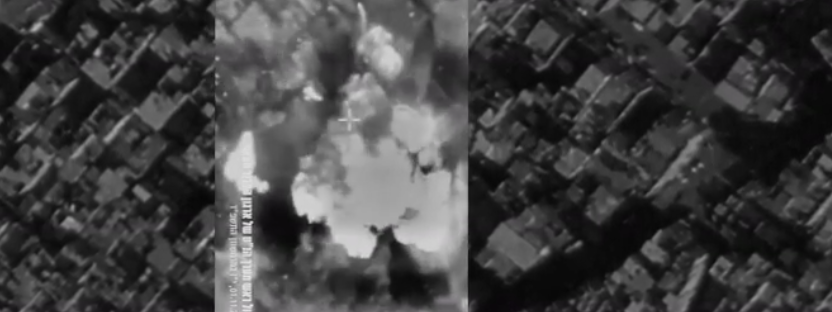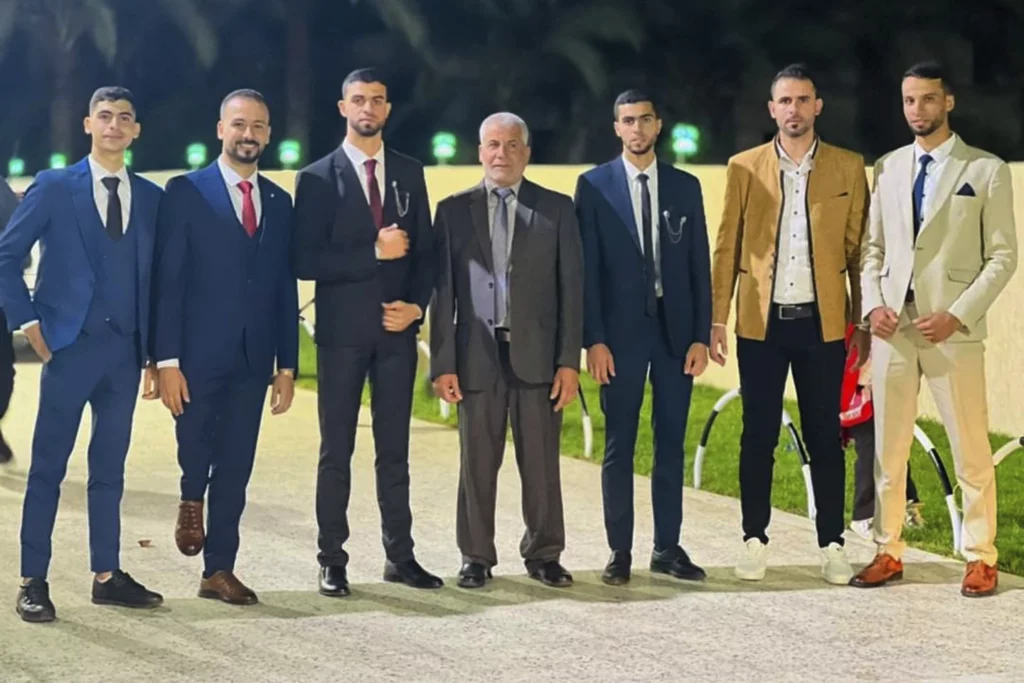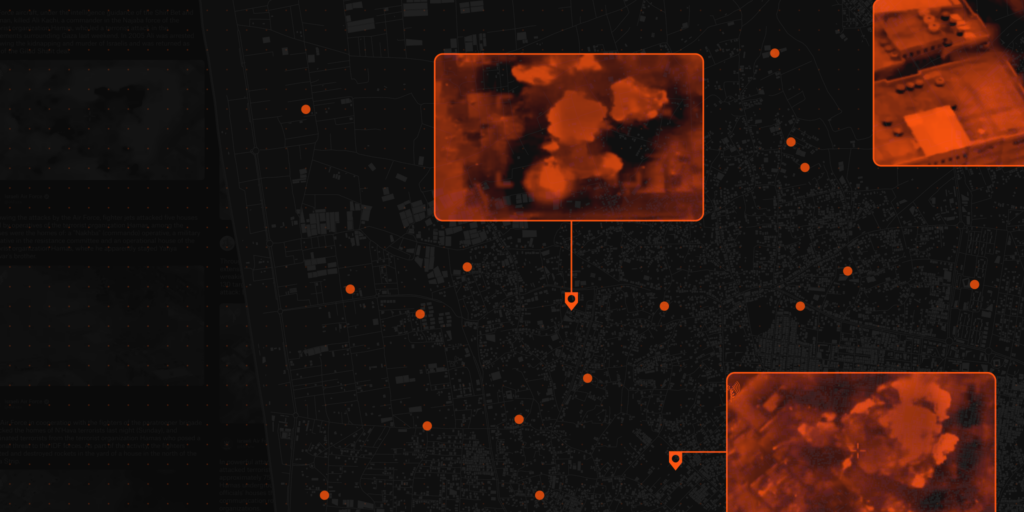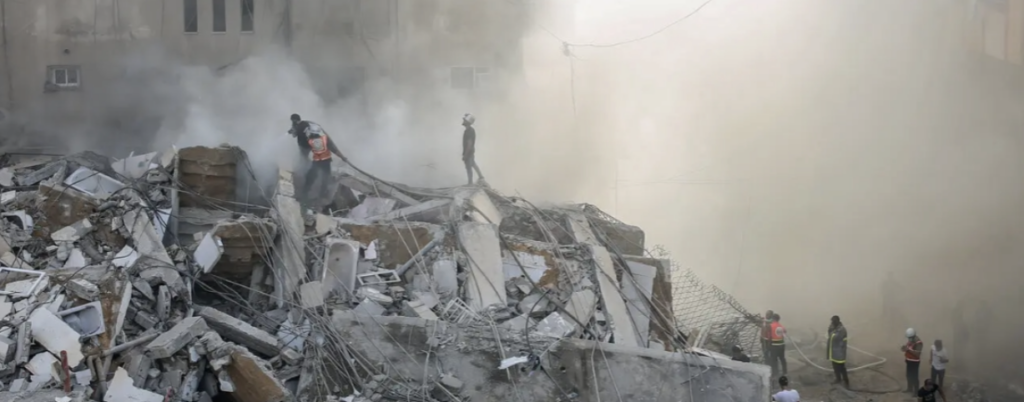Incident Code
Incident Date
Location
Geolocation
Geolocation
Airwars Assessment
On October 31, 2023 confirmed Israeli strikes on the densely populated Jabalia refugee camp killed at least 126 civilians, including 68 children. A further 280 civilians were reported injured by the director of the nearby Indonesian Hospital.
A second strike hit the same location the following day, though the full casualty assessment for that incident will be reviewed separately by Airwars. Israel has confirmed that it conducted both strikes, with the stated target being Hamas leader Ibrahim Biari, and “his base”, according to IDF spokesperson Daniel Hagari. Munitions experts speaking to The Guardian indicated that the IDF used so-called bunker buster munitions in the strike: 2,000lb bombs with an estimated crater size of 40ft which cause an “earthquake like” phenomenon on impact.
The UN High Commissioner for Human Rights raised concerns on Twitter/X that the strikes may have been “disproportionate attacks that could amount to war crimes”. Though no official civilian casualty estimate has yet been conceded by Israeli forces, IDF Spokesperson Richard Hech acknowledged that the IDF knew that civilians were present, and said that civilian harm was a “tragedy of war”.
Airwars has identified at least 116 names of civilians killed, including ten cases involving the fatality of more than one member of the same family. In three of these cases, families were reportedly killed in their entirety.
The Al Qassam brigade official page posted that seven civilian hostages taken from Israel by Hamas militants, including three holders of foreign passports, were also killed. These civilians have been included in Airwars’ upper fatality estimate only, as they have not yet been otherwise corroborated.
Numerous accounts on social media of relatives grieving over unnamed family members killed in the bombing have also been accounted for in Airwars’ civilian casualty range. When one source mentioned that a civilian and “his whole family” were reportedly killed, but the victims could not otherwise be identified, Airwars counted two civilians killed in its ranges as a minimum. In cases where sources indicated that “children” were killed without providing further information on the number of victims, Airwars counted two children killed as a minimum.
Sources also reported that “a large number” of victims were still under the rubble after the strikes, with Hamas officials, quoted by the National, reporting that 120 individuals were still missing by November 2nd. These individuals have not yet been included in the Airwars casualty toll. No reports were found to indicate that there had been prior warning of the strike.
“Apocalyptic scenes”
Footage and videos released following the strikes showed vast craters, alongside dozens of onlookers standing on the edges and people searching for survivors. Local sources have widely referred to the bombing as a “massacre”. Pictures published by local and international sources showed entire housing blocks leveled.
CNN said the survivors talked about “apocalyptic scenes in the aftermath of Tuesday’s strike”, with one eyewitness saying “it felt like the end of the world”. “Children were carrying other injured children and running, with grey dust filling the air. Bodies were hanging on the rubble, many of them unrecognizable. Some were bleeding and others were burnt,” Mohammad Al Aswad told CNN.
The Washington Post reported that “Palestinians carried away the injured and dead on blankets and mattresses”. The Guardian described “body bags piled up with horrific speed at the morgue of the nearby Indonesian hospital in Beit Lahia, and then outside the building” and added that “the wounded filled [the Indonesian Hospital] beds or were raced to Dar al-Shifa hospital in Gaza City, where medics from the Médicins Sans Frontiers aid group struggled to find space even for badly injured children”.
“Young children arrived at the hospital with deep wounds and severe burns. They came without their families,” said Mohammed Hawajreh, an MSF nurse who was quoted by the organisation in a statement condemning the attack. “Many were screaming and asking for their parents. I stayed with them until we could find a place, as the hospital was full with patients”.
Similarly, @AJA_Egypt described scenes with “rows of corpses and shrouds…Jabalia martyrs piled up in the courtyard of the Indonesian Hospital”.
One source on social media (@rdooan) said the bombing left “a hole filled with the corpses of Palestinian families”, while another source stated that “the bodies of families are crowded on top of each other”.
Rescue efforts to identify civilians in the rubble continued after the strikes, with The Guardian reporting that following the strike, “rescuers combed with their hands through surface layers of a tangled mass of concrete and steel which hours earlier had been homes in the Jabalia refugee camp in Gaza. They were searching for survivors, or the bodies of victims, which the immense force of an Israeli airstrike had left near the surface. Those trapped deeper may be entombed for months”.
Mahmoud Basal, a spokesperson for the Palestinian Civil Defense emergency services, told The Washington Post 20 buildings had been destroyed by the strikes, while Al-Arabiya wrote that the bombing “blew up an entire residential neighborhood”. One source specified that the location hit initially was the Al-Tarnis area of the camp. A number of sources qualified the bombing as a “massacre”. Journalist Anas Al Sharif described the destruction of dozens of homes in the “most populated area in the world”.
AP spoke with Abu al-Qumssan, a witness of the strike, who described what happened:“In a matter of seconds, it turned into night,” Abu al-Qumssan said. “It felt like containers of explosives and iron were dropped on us. It was a very strange and bloodcurdling sound. I couldn’t make out the streets from homes,” he said. “People and bodies evaporated.” He went to his uncle’s house, only to find the flimsy metal structure had been crushed into nothing.
Victims identified
In many cases, victims were identified on social media by survivors, relatives or friends.
The Abu Al Qoumsan family
At least 21 members of the family of Al-Jazeera broadcast engineer Muhammad Abu Al Qoumsan were killed in Jabalia. Relative of the Abu Al Qoumsan family, Mahmoud Abu Al Qoumsan, announced on Twitter/X the deaths of his relatives, namely: the three brothers Abu Al Thib Abu Al Qoumsan (Mahmoud Abo Al Qoumsan’s father), Abu Anas Abu Al Qoumsan, Abu Firas Abu Al Qoumsan. He also announced the deaths of Abu Firas Abu Al Qoumsan’s wife (name not provided), her two sons Wasel Abu Al Qoumsan and Mohannad Abu Al Qoumsan, and her two daughters Nabough Abu Al Qoumsan and Abrar Abu Al Qoumsan.
He also recorded the deaths of Umayya Abu Al Qoumsan (Mahmoud Abu Al Qoumsan’s sister), and of his sister-in-law, described as the wife of his big brother Thib Abu Al Qoumsan. While her name was not provided, the names of her children were: two daughters Rahaf Abu Al Qoumsan and Layan Abu Al Qoumsan, and three sons Abdullah Abu Al Qoumsan, Mohammed Abu Al Qoumsan, and Aboud Abu Al Qoumsan.
Imam Abu Al Qoumsan (Mahmoud Abo Al Qoumsan’s sister), and her three sons Yamen, Zain and Yazeed were also reportedly killed. Um Mohammed Abu Al Qoumsan, an Abu Al Qoumsan relative, said that her sister “Jamila Yusef Abu Al-Qumsan, mother of Rami Ahjazi” was also killed in the incident. It is unclear if she is one of the wives unnamed previously.
Ra’ed Abu Al Qoumsan announced the deaths of his father, of his uncle Abu Firas, of his uncle’s wife and children – (the uncle, his wife and children have already been included above), of his sisters and their children, of his brother’s wife and her children. No names or ages were provided by this source, and it was unclear whether all of those victims have also been listed above.
An additional member from Al Qoumsan family unit, Marwa Basil Abu Al Qoumsan was identified killed by Al-Jazeera staff on social media. On December 17, 2024, Airwars reviewed the named members of the Al Qoumsan family against the five Gaza Ministry of Health (MoH) lists that were published over the course of the year after the strike. In checking Marwa’s name, Airwars found that the MoH lists recorded her age as nine years old. As such, Airwars has updated her age status from adult to child.
To avoid double counting the deaths of members of Abu Al Qoumsan family, where names were not provided by other sources, Airwars has considered these individuals were already named in the sources above in minimum estimates, though have been considered as additional family members in our maximum estimate.
On December 17, 2024, Twitter/X user @MarkZlochin alerted Airwars of a discrepancy in the age classifications for Nabough Abo Al Qoumsan and Abdullah Abo Al Qoumsan. Reflecting a Facebook post by Mahmoud Abu Al Qoumsan posted on October 31, 2024, Airwars originally classified Nabough and Abdullah as children. This was a mistake, as Mahmoud had referred to Nabough and Abdullah as “daughter” and “son” respectively, but not as children.
As Airwars originally published this incident in November of 2023, the relevant Gaza Ministry of Health (MoH) lists were not yet available. Reviewing the incident on December 17, 2024, Airwars found that Wasel Abo Al-Quoumsan (19 years old), Nabough Abo Al Qoumsan (24 years old), Layan Abu Al Qoumsan (9 years old), and Marwa Basil Abu Al Qoumsan (9 years old) appeared on the second MoH list which was published on January 7, 2024. Their names have been included in all subsequent lists.
Matching Nabough to an individual included in the second, third, fourth, fifth, and sixth Gaza Ministry of Health (MoH) lists, Nabough’s age when killed is now listed as 24, and she is no longer categorised as a child. Wasel had been classified as an adult, and recorded by the MoH as having been 19 when he was killed, his classification remains the same. While Airwars was unable to match Abdullah to an individual included in the MoH lists, based off of a review of photos shared by Adbullah’s loved ones, coupled with the fact that he was older than his brother Mohammed, who the website “Shireen List” listed as 17 years old, Airwars has updated his age status to adult.
During the December 2024 review, Airwars also assessed that Marwa Basil and Layan, both of whom had previously been classified as adults, were both recorded by the MoH lists as nine years old. As such, their adult status has been adjusted to child.
Airwars also received concerns that the 21 members of the Al Qoumsan family that Airwars found to have been killed on October 31, 2023 were in fact killed in a strike the following day. As all of the individuals included in this incident were named by individuals online on October 31, 2023, as of December 17, 2024, Airwars maintains the veracity of the individuals named in this incident.
The Siraj family
A man identified as Abdul Salam Siraj was reportedly killed alongside all the members of his family. Ismail Mohammad Foda posted on Facebook: “My friend Abdul Salam Siraj, his entire family was exterminated in Jabalia… his mother, his wife, his two daughters, two sisters, three brothers, and his uncle’s entire family”. Airwars has been unable to separately identify the uncle’s family, and so has counted these as at least two individuals in our minimum range.
The Khudair Ali family
Muhammad Ali announced on Twitter/X the deaths of nine of his relatives that he described as “my beloved ones, my heart and my soul, my support in my country, my cousins and my sisters, in the treacherous massacre in Jabalia camp”.
He identified the victims as Fadi Khudair Ali and his wife (name not provided), Muhammad Khudair Ali, Malak Khudair Ali (described as his cousin), Khadra Jaber Ali (his aunt), and Khadra’s children: Ahmed, Zainab and Muhammad. He also named his cousin’s sons Haidar and Kanan Al-Daour. Another source said that “Umm Fadi” was grieving her sons and daughters, all killed in the Jabaliya bombing.
The Masoud family
A friend of Omar Masoud “Al-Abeka” announced Omar’s death, alongside the deaths of his wife Donia Bashir and their four children (a son and three daughters). The source described Omar as a former prisoner who was detained for twenty years for killing an Israeli, before he got released, getting married and having children. The names of Omar’s family members were not provided by the source. Sources did not explain if Omar Masoud was imprisoned for being a member of a militant group, and also did not state if Masoud was a member of a militant group at the time of his death.
The Abu Sultan family
Nine members were reportedly killed from the Abu Sultan family, which one source said was killed in its entirety.
Omar Mustafa Abu Sultan and his wife Sahar Abu Sultan (Al-Hoor), and their five children (four sons and one daughter) Mahmoud Omar Abu Sultan, Ahmed Omar Abu Sultan, Muhammad Omar Abu Sultan, Abdullah Omar Abu Sultan, and their daughter named Shahd Omar Abu Sultan. Ahmed Omar Abu Sultan’s wife, and his daughter were also reportedly killed (though names were not provided by the source). On the deaths of the Abu Sultan family, on Facebook, Suhil Yahya posted: “There are no relatives or loved ones left, they are all gone”.
The Hamad Family
Medhat Khalil and two other sources reported the death of Kamal Hamad “Abu Diaa” and his son (unnamed) in the Jabalia bombing.
The Al-Tanani family
Two children from the Al-Tanani family were reported killed by one source, namely Ahmed Salah Dhiyab Al-Tanani and Mahmoud Muhammad Dhiyab Al-Tanani. Their age was not provided by the source.
The Okasha family
At least 33 members of the Okasha family were reported killed in the strikes, according to AP. This includes husband and wife Rawand Okasha Umm Kinan and Belal Okasha, alongside their three children, as reported by their relatives Mohammad Okasha and Abood Okasha. The children’s uncle Ziad Okasha Abu Iyad and his wife Manal Okasha “Al-Najjar” were also reported killed alongside their son Youssef Ziad Okasha and sons of their late uncle Naeem Abu Raed.
Another cousin, Raed Okasha, his children, and his wife, their cousin Muhammad Okasha and his three children Rakan, Amid, and Masa were also listed among the fatalities, alongside their cousin Yasser Okasha, his children and his wife, their cousin Nael Okasha, his children and his wife Islam Muhammad Al-Kafarna Okasha. A video posted on Facebook by Mohammed Okasha showed Yasser Okasha in combat gear wearing weapons, suggesting he may have been a militant.
A post from Mona Sahle added additional names and offered her condolences to her cousin Nasser Okasha Abu Muhammad for the loss of Nasser’s daughter, her husband, and their children. Muhammad Okasha and his three children are survived by their wife and mother Samah Abu Saltah who was born in the Balata camp, and moved between Gaza and Nablus. Mohammed Okasha added the names Thaer Naeem Okasha and his family, and Muhammad Fayez Al-Zwaidi.
The Alyan family
Jehad Al Sharawi posted a memorial to her uncle Muhammad, uncle Hussein, and the Alyan family for the loss of: Youssef Muhammad Alyan, Mahmoud Jabr Alyan, Karim Majid Alyan. Ziad Alyan also posted a memorial for his brother Mahmoud Jabr Alyan.
The Omrain family
Faraj Abo Mohammed announced five deaths from Abu Al-Omrain family : Ahmed Akram Abu Al-Omrain, Reem Muhammad Al-Firi (Abu Al-Amrain), Muhammad’s wife, and of three children: Rital Youssef Abu Al-Amrain, Abdul Karim Youssef Abu Al-Amrain and Zaher Ramadan Abu Al-Amrain.
The Rayyan family
Reuters published a video of a Jabaliya resident, identified as Abdel Kareem Rayyan, holding a paper listing the names of the 15 family members that he claimed were killed in the Israeli strikes. Abdel Kareem Rayyan declared to Reuters: “I lost my whole family, 15 of them. They were innocent, just staying in the camp. What wrong did they do? All of them were killed. My sister’s house with her children, my brother’s house with his children, all of my siblings, no one left except me and my younger brother. Fifteen people, these are their names – they are innocent an kind, it’s literally a massacre, complete destruction. All of the alley, 20 houses were demolished”.
Airwars was able to identify the following names from the list he showed to Reuters: Raed Ahmad Rayyan, Hanna Rayyan, Sa’ed Rayyan, Maher Rayyan, Anwar Rayyan, Jannah Rayyan, Raed Sa’ed Rayyan, Hanaa Sa’ed Rayyan, Mahmoud Sa’ed Rayyan, Ghassan Mohammed Rayyan, Israa Mohammed Rayyan, Mujahid Mohammed Rayyan, Masa Mohammed Rayyan, Iman Saed Abou Hamdan, Karam Abdulkarim Rayyan.
Another man identified as Hassan Ahmed Rayan told Reuters in the same video “The house had 15 people in it, until this moment we cannot reach any of them. Since yesterday, we’ve been trying to find anyone, but we couldn’t. There is no equipment, no civil defense teams, it’s all personal efforts to remove the rubble”.
On social media, Ahmad Abi Ibrahim announced the deaths of his relatives his cousin and brother in law Raed Rayan Abu Saed, his “beloved sister Hanna”, described as Saed’s mother, Saed’s sister identifed as Anwar, and her sons. Janna is referred to as a younger sister with who they “recently celebrated her success in high school”.
Maher is described as a ” decent young man, [who] spent his life in obedience to God, between the mosque and the university. He completed his education as a doctor and volunteered to treat the wounded in the Indonesian Hospital at the beginning of the outbreak of the current war on Gaza.” Nassma Jamal published on Facebook: “May God have mercy on the martyrs of the Rayyan family, relatives and cousins, who were martyred while they were steadfast and sitting in their homes in the Jabalia camp massacre. The martyr Abu Saed Raed Rayan, his wife, children and some of his grandchildren, his son Saed Rayan, his wife and children, and the wife of cousin Abu Ghassan Rayan and her children. Fifteen people, most of them children.” Airwars has estimated the minimum number of children killed in the Rayan family to be six, though the exact number is not yet clear.
In addition to the victims identified alongside other family members outlined above, Airwars also identified an individual named Juma Muhammad Al-Shaarawi, whose death was announced by Baraa Samir describing Al-Shaarawi as a “good and decent young neighbor”.
Unnamed victims
As in many incidents of civilian harm, not all victims were named by sources.
The Izz Al Din Al Qassam brigade official page posted that seven civilian hostages taken from Israel by Hamas militants, including three holders of foreign passports, were killed. The identity of the hostages was not provided.
Airwars also archived a number of videos where relatives or friends spoke about their losses surrounded by scenes of desolation.
In one video published by @Roaastudies and by Middle East Eye, an unnamed Palestinian man present at the scene of the incident was recorded explaining to the camera that he had three children and “not one has survived”. He is seen collapsing at the site of the bombing screaming: “My three children are all gone! My three children, Oh God! My three children! That other day, he told me to come, he told me “Come Dad””. A man holding him replies “Maybe we’ll find one, maybe we’ll find one alive”. The camera holder then says, “this is my friend, he just lost his family”.
@ramiaalibrahim published a video including another Palestinian man whose name was not identified, was filmed walking around the rubble screaming “my son is a martyr, oh God!”, while an additional video published by @Yasser_Gaza on Twitter/X showed a grieving mother who reportedly “lost all of her children“.
On social media, one video released by @Palestinealaa19 showed a father and his son at the scene of the bombing – the young adolescent was crying over bodies in plastic bags of members of his family lined up on the street. The father can be heard telling his son “you can’t collapse, you can’t cry, this is our destiny, we are not better than them, look they are all around us, we don’t forget them and the other 8,000 people – without counting those under the rubble, at least we got out, at least we knew who they are”.
In one video published by @AJArabicnet, a child critically injured in the bombing asked his relative to give him water, while another video released by @Ahmed_GR00 shows a young girl injured with blood on her clothes. The source alleged that she lost the sight of her eyes but at the time of the recording was not aware of her fate.
@shamel__news published a video of two young girls and one young boy rescued from the rubble from Jabalia. @visegrad24 mentioned on Twitter/X the case of a young boy rescued from the rubble by rescuers at the site but no further information was provided regarding the child’s identity. Documenting similar scenes, AP recorded “Young men [carrying] the limp forms of two children from the upper floors of the crumbling frame of one damaged apartment building, while helping down another child and woman. It was unclear whether the children were alive or dead. Gray dust, apparently left by pulverized concrete, seemed to coat nearly everything.”
One Twitter/X the user @Mohammed78990 published a video of a baby followed by this comment: “painful scene from the Jabaliya massacre”. The same source explained that the mother was killed in the bombing. In another video released by @AJA_Palestine, a young man and his young sister were filmed sitting on the rubble crying over the death of their father.
Overall casualty estimates provided by sources
Initial reporting following the first Israeli bombing on October 31st recorded “a number of martyrs” and “dozens” injured, with Bellingcat setting the initial death toll at “at least 40 killed”, followed by the Guardian which initially reported that “47 bodies were “recovered from the rubble after an explosion in several houses in Jabalia camp”, analysing video footage published by Agence France-Presse.
The director of the Indonesian hospital, Mohamed el-Ron, told the BBC that the hospital recorded 400 casualties, “including 120 dead”, the majority being “women and children”. In a press conference held at that hospital on October 31st, doctors announced that “at 4pm the Indonesian hospital received a high number of killed and injured after an attack on residential block in Jabaliya camp”. The medical staff stated that “one staff member lost four members of his family during the strike.” The same source added that the number of civilian casualties was bigger than their capacity. A number of sources reported “hundreds of injured and killed” following the two declared rounds of strikes on Tuesday and Wednesday. – with @ajmubasher reporting “more than 400 martyrs and wounded”, without further details.
On October 31st, the Palestinian Ministry of Health initially counted “50 martyrs and around 150 wounded and dozens under the rubble in a heinous Israeli massacre that targeted a large area of homes in Jabalia camp”. Later in the day, the MoH said it feared at least 100 had been killed in the bombing, and hundreds others injured, according to @ariel_oseran.
Airwars’ civilian fatality range reflects the number of individuals identified by local sources (both named and unnamed). As per our methodology, where specific numbers of civilians were not explicitly mentioned (such as reference to ‘multiple’ children), we have counted these as at least two casualties. Very few sources were able to report on exact numbers of those injured in the first strike, so Airwars has taken the number originally shared by the Indonesian Hospital of 280 injured civilians.
Israel Defense Forces statements on civilian harm
IDF spokesperson Lt Col Richard Hech acknowledged the Israeli strike had “destroyed a big chunk” of the Jabaliya camp. Hech declared that Israeli forces were aware that the area they targeted was an area where many civilians lived but refused to comment on any civilian casualties resulting from their actions. He justified the strike saying that their focus was on “a senior Hamas commander” who “sadly…was hiding again as they do behind the [sic] within civilians. And that’s all I can say at this point. (…)”.
Similarly, The Guardian reported that according to the IDF “some cavities seen in images of destroyed camp buildings were created by the collapse of tunnels that had been dug by Hamas, which [IDF spokesperson Daniel Hagari] said chooses to put key military infrastructure below areas where many civilians gather.”
Military spokesman Jonathan Conricus quoted by AP News stated that the apartment buildings collapsed “only because the vast underground Hamas complex had been destroyed.” Similarly, AP News reported that “Brig. Gen. Daniel Hagari said an underground Hamas installation beneath a targeted building collapsed, toppling other nearby buildings. Conricus later said the main strike had hit between buildings. “We don’t intend for the ground to collapse,” he told reporters. “But the issue is that Hamas built their tunnels there and that they’re running their operations from there.”
Though the IDF did not confirm the exact numbers of civilian casualties, interviews conducted with IDF spokespeople indicate that Israeli forces have acknowledged civilian harm as a result of their strikes on Jabaliya camp. Airwars has therefore graded the civilian harm status of this incident as “confirmed”, and archived relevant excerpts from interviews in the ‘strike report’ section at the end of this assessment.
On November 1, 2023, the Israeli Air Force Twitter/X account posted a video of an airstrike, along with an image of a young man they identified as Muhammad Atsar. The post claimed that Muhammad was Hamas’ “head of the anti-tank system” and that he was killed in the airstrike. The coordinates of the site of the recorded strike match those determined by Airwars’ research team. As such, this source has been used to record this incident as declared. However, beyond the Israeli Air Force statement, Airwars did not find reports stating that someone by the name of Muhammad Atsar was killed in this incident. As such, Muhammad has note been included among the list of those killed in this incident. This will be updated should additional information become available.
Combatant fatalities
The October 31st strike was reportedly intended to target Ibrahim Bari, described as a top commander of Hamas’s central Jabalia battalion, and a key commander during the deadly attack inside Israel on October 7th. Israeli forces believed that Biari had also been “leading fighting in northern Gaza from a network of tunnels under the camp,” according to The Guardian.
According to The Guardian, Daniel Hagari announced Biari’s death alongside “scores” of Hamas militants – without providing the total number of combatants killed. He added that the strike on the building Biari was in “led to the collapse of other things because there was a very extensive infrastructure there.”
@AvichayAdraee on Twitter/X released an IDF video in Arabic where Israeli forces claimed to have killed Hamas leader Ibrahim Al Bayari on October 31st in middle of Jabalia, alongside “many elite members” of Hamas. During a briefing (quoted by The Guardian), IDF spokesperson Hagari declared that “There are dozens of terrorists that have been killed with [Bayari], and the ‘metro’ underneath has collapsed, so it made this hole that you see in the area. We are dealing with terrorists that build the system of infrastructure of terror underneath the Jabalia refugee camp for a big reason. They want this picture of destruction.”
Hamas militants “strongly denied the presence of one of its leaders in the refugee camp” according to CNN, with AP adding that “Hamas spokesman Hazem Qassem denied the military’s claim, saying it was trying to justify “its heinous crime” against civilians.”
With ambiguity around the exact number of militants killed, Airwars has applied a 12-24 combatant casualty range to account for comments such as ‘dozens’ of targets killed.
Munitions used
While a video of the moment of the bombing was released by IDF forces on social media, the IDF spokesperson reportedly refused to comment on the number of munitions used or their types or identify “which craters were caused by tunnel collapses” – indicating that Israel would provide information at a later stage, according to The Guardian.
The Guardian reported “at least five craters in the densely populated refugee camp, which weapons experts said were left by the use of multiple JDAMs – joint direct attack munitions – in the airstrike.” Former Pentagon munitions expert Marc Garlasco also told The Guardian that “the biggest crater at the site looked like a hit with a GBU-31.” “There are other bombs it could be. That one just fits best with all the evidence. The estimated crater is around 40 ft [12 metres]””.
A former United Nations weapons inspector Chris Cobb-Smith, told The Guardian, “The munition is almost certainly JDAM, either a GBU 31 (Warhead Mark 84) general purpose bomb or possibly a GBU 56 (Warhead BLU 109) bunker buster. Both about 2,000lb [900kg].”
According to The Guardian: “The GBU (guided bomb unit) is a precision-guided air-to-surface weapon system. It is part of the Israeli arsenal provided by the US and also manufactured by Israel under contract. These Boeing-manufactured GBUs use a tritotal, which is an explosive mix of TNT and aluminium powder, used commonly in air-dropped bombs. The Israeli air force recently posted images of dozens of GBU-31 being loaded on planes. “This fits our analysis. You can see the size of the bomb and guidance straps, which are the signature of the GBU-31,” added Garlasco.””
Garlasco also told The Guardian that “the type of munitions he believes were used would have met stated Israeli military goals of hitting underground tunnels, but also caused extensive damage above ground. If they are set to have a delayed detonation, which is one of three options on the bomb, they cause an earthquake-like phenomenon when they do explode. “JDAMs will burrow through the ground, and have a delayed detonation, causing the building to collapse on itself. This explains the extent of the damage,” he said. “Buildings also collapse due to the blast wave, not just tunnels”.
According to Bellingcat, on October 31, “Reports began to appear online about 2:30 pm local time (…) A Reuters live stream filming towards Jabalia and Gaza City appears to have captured a large explosion at approximately 2:24pm local time, consistent with the earliest reports of the strike on Jabalia.” This observation matched The Guardian’s findings, which noted that “The first online reports of Tuesday’s attack came at about 2.30pm local time. A Reuters live stream captured the moment of impact a few minutes earlier.” According to The Guardian, relying on Reuters video footage and other media content, the exact location of the strike was narrowed to buildings at the intersection of Al Mouhawel and Al Almey streets.
Note that at the time of publication of this assessment, the Ministry of Health had not yet released an update to the list of named fatalities originally published on October 26th.
Assessment Updates
Victims
Family members (21)
Family members (12)
Family members (10)
Family members (6)
Family members (9)
Family members (2)
Family members (5)
Family members (15)
Family members (3)
Family members (26)
Family members (2)
Individuals
Key Information
Geolocation Notes
Reports of the incident mention strikes on the Jabalia camp (مخيم جباليا). Satellite imagery shared by Christiaan Triebert (@trbrtc) shows the strike location at the following exact coordinates: 31.533320, 34.499070. The Airwars team matched these exact coordinates to a screenshot taken at 0:00 of the strike video shared by the IDF to Twitter/X (https://x.com/idfonline/status/1719770638716444906).

Imagery: IDF
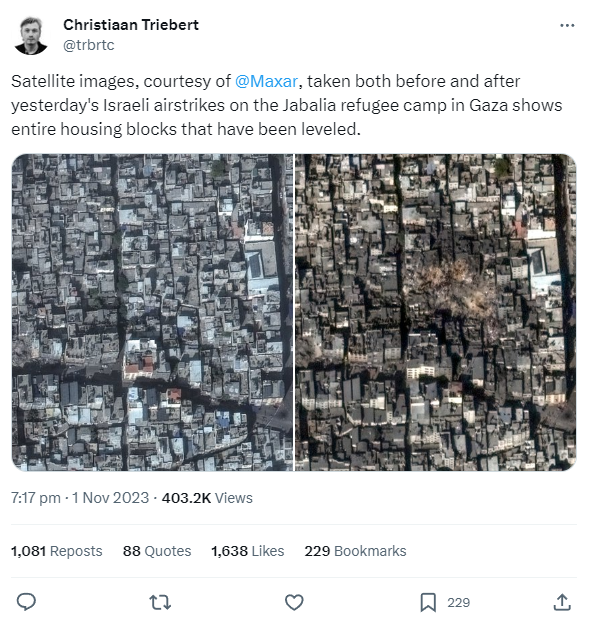
Imagery: @trbrtc
Military Statements
Referenced

